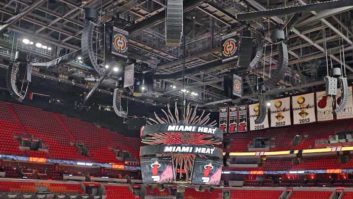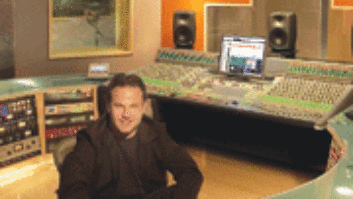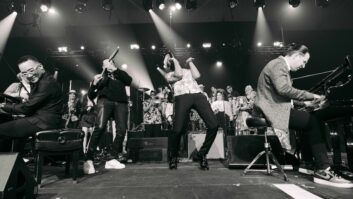These are boom days for the Miami recording community. The pop and Latin music renaissance that this city is experiencing has given the region a profile it hasn’t enjoyed since the heady days of the 1970s, when Eric Clapton, the Allman Brothers, the Bee Gees, KC & the Sunshine Band and a host of other music giants camped out in Miami recording hit after hit, buying expensive homes, fast cars and, in some cases, premium-grade cocaine. Those fast times set the stage for the mass-market packaging of Miami as a degenerate Sodom in television’s Miami Vice, which reduced the city to a pastel and chrome cliche, the last flash of style over substance before the musical lights dimmed for over a decade in South Florida. Which is not to say there wasn’t a vital recording scene; just that it no longer had the sort of national profile it once did, the popularity of the Estefan clan’s records notwithstanding.
But all that has changed with the success of Ricky Martin and a host of other Latin and pop artists who have swarmed out of Miami and topped the charts in 1998-99-a creative surge that shows no sign of slowing anytime soon. Not surprisingly, this has been very good news for Miami’s studios.
THE NEW MODELThe most notable trend in Miami studios recently has been the proliferation of a new breed of music facilities, ones featuring a compact, acoustically valid recording space coupled with a control room fitted with a hard disk recording system and no traditional large-format console, but with significant outboard equipment, quality microphone preamps and racks of A/D converters. The core of this trend is not hybrid facilities-project studios that go partially commercial for economic reasons (their owners are often producers, engineers and/or composers who do use their own facilities for their own projects). Rather, these facilities were started specifically as commercial, for-hire ventures, much like conventional studios. But their size, capital investment and technology complement set them apart.
“It’s songwriter- and producer-driven,” says John Arthur, a Miami-based facility designer who has been involved with a number of these new types of studios, including Emilio Estefan protege Estefano’s Midnight Blue facility. “But no one’s throwing away the demos anymore, so they need conventional studios that have both the technology they’re used to and an economic structure that can accommodate a wide range of projects.”
“South Florida tends to be younger in terms of the people who come here for music, whether they’re from Latin America or North America,” observes Doc Wiley, partner and chief engineer at Digi-Note Studios, which opened in the trendy and youthful South Beach section in 1999 with a 24-bit Pro Tools/Pro Control system, the typical setup for this new class of facility. “These are people for whom hard disk recording comes very easily and naturally. I have a lot of clients who have never worked on tape at all.”
On average, younger artists and producers tend to have lower budgets, as do Latin records, which are for the most part still marginal in the grand scheme of music sales but perfect for Miami’s role as the gateway to much of Latin America. This fits well with the $1,000 to $1,200 daily rates that facilities such as Digi-Note, Big Dog, Ocean VU and others charge. “This is very affordable for Latin artists and producers, and for American A&R departments that want cost-effective ways to develop and record new acts,” Wiley says. “They can use studios like these for developing ideas or for making the final record, all pretty affordably. Plus, it interfaces well with the home studios that a lot of local artists have.”
Even though 24-bit hard disk technology has taken its place as an accepted standard within the industry, Wiley believes it’s still new enough to demand extra marketing efforts to the larger industry. “Not all the ‘console jockeys,’ as we call them, are sold on hard disk recording,” he notes. “There is a perceptual battle we face. But once we do win one of them over, they see that it’s one more option they have for a bigger variety of projects and budgets, and for a wider range of facilities they can access.”
The initial success of this type of facility in Miami has potentially significant implications for the entire industry. Gary Baldaccini-who built his recently opened, Pro Tools-equipped Big Dog Studios for $500,000, including the real estate-says, “I wouldn’t want to be marketing half-million-dollar consoles down here right now, when we’re building entire studios for that amount. The ability to record, overdub and mix in a hard disk environment is becoming much more accepted throughout the industry, and it’s a lot more affordable.” (Indeed, Ricky Martin’s chart-topping “Livin’ La Vida Loca” was completely recorded and mixed in producer/writer Desmond Child’s three-studio, all-Pro Tools facility, the Gentlemen’s Club, in Miami.)
Charles Dye, an engineer and co-owner of Heaven Studios, believes that a wave of MDMs wiped out much of Miami’s studio middle class a decade ago, and what facilities like his, Digi-Note, Big Dog and others represent is a new middle class, powered by 24 bits and affordable rents. “Pro Tools has really driven it,” he says. “And in the process, it’s also creating more work for engineers here.”
But is this new model inherently limited, in terms of being able to expand to accommodate business growth? Baldaccini says his response to growth would simply be to build more rooms like his present one, essentially cloning the model, “which is a lot easier than building another Neve room at a larger studio. And when business contracts, it’s a lot less hard to close that kind of room down to scale the business back.”
THE TOP TIERNot long ago, I had lunch with a real estate agent, a native of South Florida, who regaled me with tales of the field day he is having buying out-at 50 cents on the dollar-condos from those who bought into the area during the height of the real estate boom in the 1970s. That was before the bottom fell out during the pseudo-recession of the early 1990s, which hit Miami harder than most cities. “It’s my way of getting back at New Yorkers,” he told me. When asked what New Yorkers had ever done to South Florida, he replied, “They paved it!”
And that is what the Germano family of New York, owners of The Hit Factory, have been doing with Criteria, Miami’s grand dowager of audio, since purchasing the facility in January 1999. The result of nearly a year’s worth of work is a complete acoustical, technological and aesthetic rennovation of the facility-including a repaved parking lot. Now renamed The Hit Factory Criteria Miami, the six-room facility had all six studios up and running by this past March, along with an in-house mastering suite, a Pro Tools editing suite, and two pre-production rooms. The console complement includes a vintage Neve 8078, Euphonix System 5 digital console, Sony Oxford OXF-R3, SSL 9000 J and G Plus, with other additions planned. (For more on the studio, see the story on page 40.)
While the acquisition of Criteria by The Hit Factory has gotten a lot of attention, Miami’s upper-echelon facilities have remained remarkably stable during the past decade or so. In addition to Criteria, facilities such as Crescent Moon, Middle Ear, South Beach Studios and Fort Lauderdale’s New River are all still thriving after anywhere from seven to 20 years in existence.
This is in part attributable to the fact that most of these facilities have a significant anchor client, be it the owner or someone else. South Beach Studios, opened in 1992, is the studio property of Island Records founder Chris Blackwell, whose development of several super-hip hotel properties is responsible for much of the South Beach district’s renaissance. In this case, the anchor is not Blackwell’s own Palm Pictures but projects by producer/engineer/mixer Tom Lord-Alge, who started using the facility four years ago and liked it and Miami so much that he bought a residence and came close to buying the studio itself. Lord-Alge’s work continues to account for as much as 80% of the studio’s booked time.
Joe Galdo, president of South Beach Studios and regional A&R for Palm Pictures, acknowledges both the benefits and the burdens that such a relationship brings to a studio. But while that would be the case in any city, Galdo notes that it might provide insight into why Miami hasn’t expanded its base of high-end facilities much. “At the end of the day, Miami is still a relatively small community, and it’s very person-oriented,” he explains. “The work tends to follow the people-the producers and engineers, and now more and more the songwriters who are becoming producers. And many of them are developing their own studios, which lessens the need for more commercial studios here. While Miami has lots of rock music, the Latin stuff doesn’t need big rooms the way rock does. I think that’s why it’s been pretty stable here.”
Lord-Alge is among a number of high-profile music makers who’ve made the move to Miami in recent years. Rocker Lenny Kravitz sold his Manhattan townhouse-cum-personal studio last year and moved south; noted mixer Bob Rosa (Mariah Carey, C&C Music Factory) also moved from New York last year, opening his own studio, Bogart Recording, with several partners. If Lord-Alge’s experience is any indication, even a small shift by the right people could boost Miami further. “Ninety-five percent of my work is imported,” he says. “South Beach has never been our little secret, but at the moment, there’s more of a focus on this part of the world.”
Crescent Moon, which opened in 1991, is the base of operations for Miami production heavyweight Emilio Estefan, whose wife, Gloria, is simply the tip of a production empire that now includes a custom label with Sony Music Entertainment and a stable that includes 15 exclusive producers and nearly 20 staff songwriters. Studio general manager Kevin Dillon acknowledges that more than half of the studio’s business comes from Estefan’s ventures, and agrees that such in-house situations contribute significantly to the stability of the city’s upper-end studios, as has the consistency of the Latin music production base. “You have to remember that Latin music has always been done down here,” he says. “It’s just now that the rest of America is waking up to it.”
The Estefans still own a property on South Beach, a possible location for the new production facility that Dillon says has been on the drawing board for years and remains a definite plan with an indefinite timetable.
Middle Ear Studio owes its longevity-this is its 20th anniversary-to its owners, the Bee Gees, who continue to account for the vast majority of its bookings. Despite time rarely being available for outside clients, the studio underwent a major upgrade last year, adding a Neve Capricorn console and new acoustics. Studio manager and chief engineer John Merchant says he’s been fielding more calls about the studio in the last year, which he attributes to Miami’s upswing as a media center and hip vacation destination. But he adds this insight: “The common wisdom in the studio business is never depend on one or two anchor clients, because when they decide to move, you could lose everything. But in Miami, doing the exact opposite of that is probably what’s made this level of studio here so stable.”
There are a number other factors that affect Miami as a media recording base. For starters, geography (and climate) is destiny here. Between its sweltering summers and its latitude astride the hurricane highway, Miami has long accepted its fate as a seasonal location. But that is offset to a degree by Miami’s other ace in the hole: its position, geographically and culturally, as the gateway to Latin America. Miami in July isn’t much more difficult to bear than midsummer in Kingston, Caracas or Bogota. And for those who are used to it, seasons aren’t an issue, which bodes well for Miami as the entire Latin American media industry revs up. Besides the current music trend, there’s been increased production of television, films and multimedia throughout Latin America. This relationship is likely to provide Miami with solid footing as a media base long after Ricky Martin’s last hit single.
THE FIDEL FACTORStill on the subject of geography, Miami is also perfectly positioned to take advantage of the day-which could be tomorrow or ten years from now-when Fidel Castro dies and Cuba turns to democracy. The film Buena Vista Social Club only hints at the potent musical power that remains untapped in the time capsule that is blockaded Havana, less than a 30-minute flight from Miami International.
“Havana is like the Nashville of the Caribbean,” observes Nancy Mraz, former South Beach Studios manager and now a local industry consultant. “Some of the musicians have been coming back and forth for years, but that hasn’t been easy until very recently, and it’s still a lot of paperwork.” But once the Sugarcane Curtain comes down, it’s inevitable that there will be increased interaction between the musicians and artists of Cuba-some of whom, such as Los Van Van, Cafe Tacuba and Cubanismo, are already making inroads with American audiences-and the studios of Miami.



